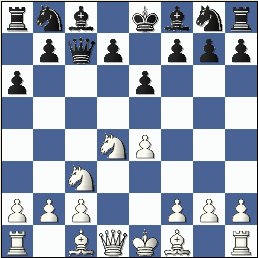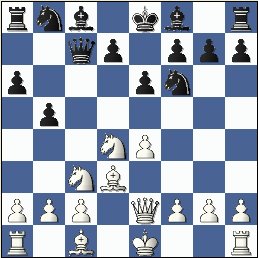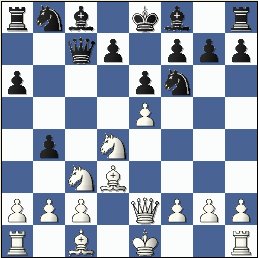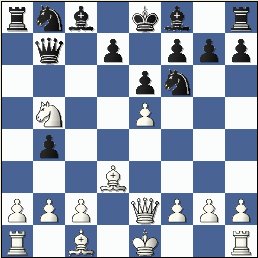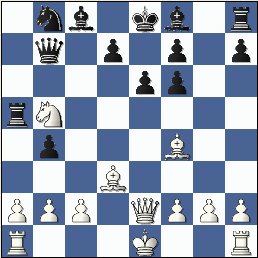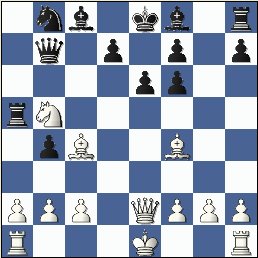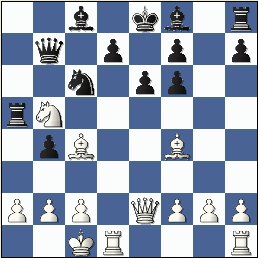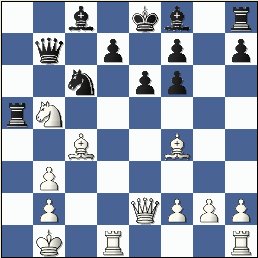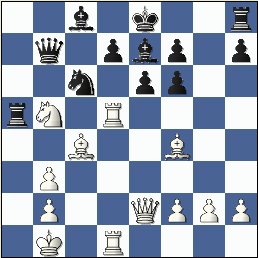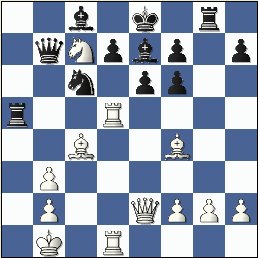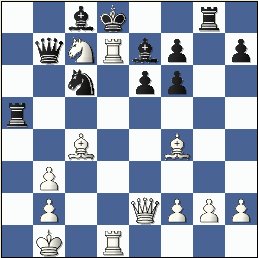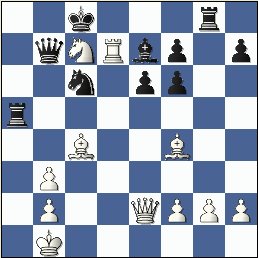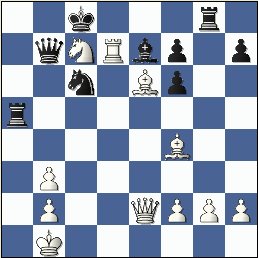GM Emil Sutovsky
(2679) - GM Abhijit
Kunte (2532)
|
|
|
***********************************
See the main game {for this month} for a complete breakdown of the opening.
[ Also possible is:
5...Nc6!?;
and also (of course)
5...Nf6;
{Diagram?}
with a good game for Black ...
with either move here. ]
6.Bd3 Nf6;
7.Qe2!?,
Did White play this move to get
his opponent out of book? Or is
this line a specialty of Sutovsky's?
[ More 'normal' is: 7.0-0, "+/=" {Diagram?} with a slight edge for White. ]
7...b5!?,
('?!')
{See the diagram ... just below here.}
I know this is a 'book' line here,
but to me it is rather too risky.
***********************************
|
|
***********************************
With forcing moves, White gets a fairly large and distinct advantage.
[ Probably better is:
(>/=)
7...d6; 8.f4, "+/="
{Diagram?}
and while White is solidly better
here, it hardly seems likely that
Black will be blown off the board ...
the second player's position
is
just too solid here! ]
8.e5! b4!?;
(hmmm)
{See the diagram - just below.}
OK ... we are out of my 'book'
knowledge. Further - I could not
find this particular line anywhere.
(It is possible it was buried in a
sub-line in ECO ... and maybe
I just missed it. NCO, page 185 -
has some lines similar to this;
but I saw nothing that included
both Bd3 and an early Qe2.)
***********************************
|
|
***********************************
Black appears to be playing with fire.
[ Ugly was: 8...Ng8; 9.Bf4, '±' {D?} but maybe this was safer than what occurred in the game. ]
9.Ncb5! axb5;
10.Nxb5, (TN?)
This - of course - looks great for
White ... taking on f6 was also a
fairly viable option here.
[ The only other game that I could
find in the database was:
10.exf6!? gxf6; 11.Nxb5 Qb6;
{Diagram?}
If instead, the move of ...Qb7;
here would have transposed
into this game.
12.Qf3 Ra5?; {Diagram?} This looks very doubtful.
( >/= 12...d5 []; 13.Qxf6, '±' )
13.Qxf6 Rg8; 14.Be3 Bc5;
15.Nd4 d6!?; 16.Nb3!?,
{Diagram?}
This looks rather tame, Bxh7,
or even Rg1 - was probably
better than this.
( The simplest was: 16.g3, '±' )
16...Bxe3[]; 17.Nxa5,
"+/=" ('±')
{Diagram?}
White went on to win in 39 moves
in this entertaining struggle.
E. Najer
(2606) - K. Landa (2550);
/
The 57th Russian Championships
(Qualifying Tournament)
/
St. Petersburg (R7), RUS; 2004. ]
10...Qb7?!;
{See the diagram - just below here.}
This looks too passive, a more
active move was called for here.
(Like >/= 10...Qc5.)
***********************************
|
|
***********************************
How can you play a move like an early ...b5!?!!!!??!; and then get wimpy with a move like this?
[ The move of: 10...Qb6; {Diag?} transposes to the note above. ]
11.exf6 gxf6;
This looks more-or-less forced,
the capture on g2 loses outright to
the simple move of Be4 here.
**************************************************************************************************
Now both Be4 and the move
actually utilized in the game ...
are very attractive for White.
12.Bf4!,
'±' 12...Ra5;
{See the diagram - just below.}
It is time for another diagram.
***********************************
|
|
***********************************
White is so much better here it is not even funny!!! ('±' or even "+/-".)
[ Not: </= 12...d5?; 13.Nc7+, etc. ]
13.Bc4!?,
(hmmm)
{See the diagram ... just below.}
Not at all bad or even inferior,
but maybe a tiny bit unnecessary?
***********************************
|
|
***********************************
{Apparently Sutovsky wants to castle on the Queen-side ... but does not want to worry about losing his QRP.}
[ The box prefers:
(>/=) 13.0-0 Na6; 14.a4 bxa3!?;
15.bxa3 Qc6!?;
16.Na7 Qa8;
17.Nxc8 Qxc8; 18.Rfb1,
'±' {Diagram?}
White is clearly better here,
if not just winning outright. ]
13...Nc6!?;
(Maybe - '?!')
Black plays aggressively here ...
when the move that defended the
a6-square might have been just
a little wiser.
[ Maybe better was: (>/=) 13...Na6; to prevent the Knight check. ]
14.0-0-0!?,
{See the diagram - just below here.}
Very wild, very complicated.
***********************************
|
|
***********************************
I no longer have a real clue as to what is going on here!
[ Better is: >/= 14.Rd1!, '±' - Fritz. ]
14...b3!;
15.cxb3!?,
This is really crazy ... why would
White willingly bust up his own
Pawn structure???
[ >/= 15.axb3 e5!?; 16.Kb1!, '±' ]
15...Rxa2;
16.Kb1, ('!')
Definitely the safest move now
for White.
[ Possible was: </= 16.Bd6!?, "~" {D?} (completely unclear) ]
Now
White intensifies the pressure.
16...Ra5;
('!?')
{See the diagram - just below.}
***********************************
|
|
***********************************
17.Rd5!
Be7!?;
The box prefers ...Rg8; here.
18.Rhd1!,
(Maybe - '!!')
{See
the diagram - just below here.}
White continues to increase the
pressure by mobilizing all of his
forces to the critical part of the
chess board.
***********************************
|
|
***********************************
Neither player can be accused of being un-original or backing away from a fight here!!!!!
[ 18.Nd6+!? Bxd6; 19.Bxd6, "+/=" ]
18...Rg8;
19.Nc7+!!,
{See the diagram - just below.}
At first this looks just like a random
move and the proof of the very old
saying:
"Patzer see a check, potzer
take a check!"
***********************************
|
|
***********************************
This is a good place for a "look-see." {diagram?}
[ Easy was: 19.g3!, '±' {Diag?} with a solid edge for White. ]
Black's reply appears forced.
19...Kd8[];
20.Rxd7+!?,
{See
the diagram - just below.}
Super-ULTRA brilliant ... ('!!!')
or simply an inaccurate move? {Probably the former, here!}
***********************************
|
|
***********************************
After several DAYS of studying this game ... I am still NOT SURE!!! :p
[ When I was first going over this
fantastic clash, I expected
something like the following:
(>/=)
20.Rxa5!? Nxa5; 21.Ba6,
"+/=" ('±') {Diag?}
with White clearly on top.
(One version of ChessMaster
prefers this line here.) ]
Black's next two moves are
- without question - 100% forced.
20...Bxd7;
21.Rxd7+! Kc8[];
{See the diagram - just below here.}
I am sure that Black would like
to play something else here ...
***********************************
|
|
***********************************
It is easy too see how uncomfortable Black's King is here ... almost completely surrounded by his opponent's pieces.
[ But definitely not:
</= 21...Kxd7??;
22.Bxe6+! fxe6; 23.Qxe6+ Kd8; 24.Qxg8+,
etc.
White has an easy win. ("+/-")
]
22.Bxe6!!,
(wow)
{See
the diagram - just below.}
Here Sutovsky should be penalized
30 yards ... for un-necessary
roughness, ... AND totally reckless
behavior!!
***********************************
|
|
***********************************
I guess Emil must have eaten his Wheaties before this game!
[ Or 22.b4!? Qxb4; "~" ]
22...Ne5?;
(Urgh)
Under severe duress, Black
begins to falter. (Problems with
the clock here?)
[ Black had to try:
>/= 22...Re5[];
23.Bxe5 fxe6; 24.Rxe7 Nxe7;
25.Bd6 Qc6; 26.Qxe6+ Qd7;
27.Qc4!, "+/=" ("±")
{Diagram?}
when White is better ... but a
clear, forced win might still be
a long way off here.
******************************************************************
Simply losing outright was:
</= 22...fxe6?;
23.Qxe6 Qa7; {Diagram?}
The box says that this is forced.
( </= 23...Nd8??; 24.Rxd8+! Kxd8; 25.Qxg8+, ("+/-") and mates. )
24.Rxe7+! Kb8; 25.Nb5+!, "+/-" {Diag?} and D.J. says it is mate in 4. ]
23.Nb5!,
(Very nice.)
A rather unexpected zwischenzug.
(It also wins the Black Queen.)
[ Or
23.Na6 fxe6; 24.Rxb7,
"+/=" {Diag?}
and White will still have to
work
very hard to prove the win. ]
23...Qxb5!?;
I don't think it matters anymore
what Black plays from here.
[ After the moves:
</= 23...Nxd7?!; 24.Qc4+ Kd8;
25.Bc7+ Ke8;
26.Bxf7+ Kf8; 27.Bxg8,
("+/-") {Diagram?}
Black will have to play major
give-away to try and stop the
impending mate on f7.
*******************************************************************
Black is also in a bad way after
the following moves:
"=" 23...fxe6!?; 24.Rxb7 Kxb7;
25.Qe4+! Kb6; 26.Be3+!, "+/-"
{Diag?}
and the end is near. ]
The
rest really requires no comment.
24.Rd5+!
fxe6; 25.Rxb5 Rxb5; 26.Qxb5 Rg6!?; 27.Qe8+!,
"+/-" {Diagram?}
Black
pretty much realizes that he is dead lost here and decides to graciously
resign.
(If now ...Bd8; then simply QxP/e6+ is a relatively easy win, especially
if you are a GM.)
An
extremely wild game, but maybe one that was not completely
sound.
(But it was sure a lot of fun!!!!!)
1 - 0
*******
Copyright (c) A.J. Goldsby, 2004. All rights reserved.
